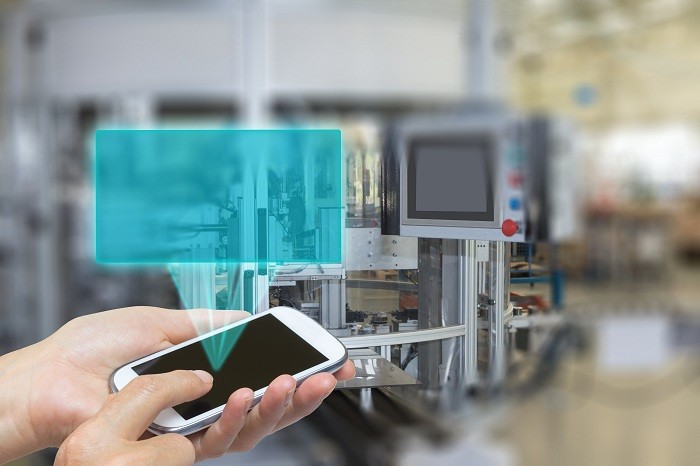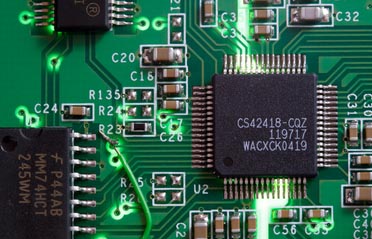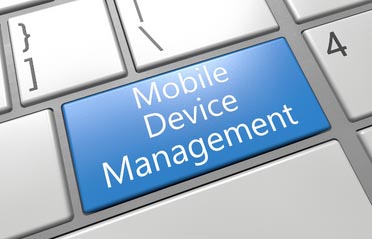The Connected Life
The Internet of Things or simply IoT is believed to benefit the consumers and at the same time, improve the productivity of industries and enterprises. The IoT uses wireless devices that connect to each other and with the help of internet and minimum human intervention helps deliver services that would meet the needs of a variety of industries.
The IoT sector is relatively new and is still in development stages. However, experts believe that the impact of IoT will be considerable.
Female is using the smart phone Blank transparent rectangle radiates from the screen smart phone. The rectangle is ready for your text. The automatic production line is in the background. The edges of the pictures are deliberately blurred.[/caption]
How IoT can Solve Manufacturing Challenges
Manufacturers and enterprises face a constant pressure to continuously improve their services and operational performance. This to a large extent has been made possible with the use of modern equipment and innovative technology. However, there are manufacturing challenges that need to be addressed.
Most modern manufacturing processes use intelligent ‘smart’ devices and equipment. And if you combine the amount of information generated by automation systems, sensors, wireless tools and other devices, you come up with overwhelming data volume that cannot be easily stored or analyzed.
The traditional manufacturing systems sadly were not designed to analyze or interpret tons of data but the Internet of Things can change the way how manufacturing systems work. Simply put, the IoT platform gives enterprises a chance to achieve operational excellence. Yes, it now comes down to reaching operational innovation and excellence with connected ‘smart devices.’
Benefits of IoT Platform for Manufacturing
Perhaps the best thing about the Internet of Things is that it integrates with your existing manufacturing processes. You can easily connect all devices, systems and even people involved in the manufacturing process for better and faster decisions.
Remember the key to IoT platform success is its rapid application. The approach works almost instantly which reduces manufacturing efforts and at the same time, minimizes your manufacturing costs and risks.
For manufacturing units and industries,
- IoT provides a chance to aggregate data from various intelligence systems, people, and equipment into operations. This will also help achieve faster and better decision making.
- IoT can make higher operational performance a reality. You can use key performance indicators to get real time insight into operational performance and compare results.
- It is believed that the use of internet and connected devices can replace paper based and manual processes. On the other hand, you can also integrate information from multiple systems within a small fraction of time to improve productivity and quality.
- 4. Being able to compare and evaluate manufacturing performance and productivity metrics without the need for physical system integration can help improve supplier quality.
- IoT makes real time asset tracking possible. Manufacturers can now track the status of moving and fixed assets such as equipment, fixtures, tooling and even goods in transit.
IoT and Predictive Analysis
The Internet of Things can remove the complexity associated with the advanced analysis. What’s even better is that IoT can be used for predictive analysis which would deliver proactive information to decision makers.
Remember that delivery of proactive information can improve quality and performance of complex manufacturing processes. On the other hand, enterprises can fix, rectify processes before extensive failure occurs.
For example, auto manufacturers can use IoT to monitor car performance and alert drivers for potential repairs. Healthcare facilities can use IoT to alert doctors about potential health issues earlier than ever before. Boston Medical Centre, for example, uses sensors in neonatal ICU which alerts nurses via smartphones when significant changes in a baby’s vital signs are detected.
Experts suggest that IoT will change the performance of medical devices. The intelligent and smart IoT devices can offer medical professionals as well as patients’ greater independence while having their health, physical activity and safety measured and supervised.
Mobile Connectivity and IoT
Mobile connectivity is believed to rise dramatically with every passing day and by 2020, the number of connected devices could reach 25 billion. The increasing use of mobile networks and the ability to connect a broad range of devices including phones, tablets, laptops, TVs, cars, building and even machinery is what enables the development of new services and applications.
When devices and equipment are allowed to communicate with each other without human interaction or intervention, you can actually open up the doors to new business models and revenue streams. In many cases, you can use IoT to refine existing technology and invent new products. The IoT and Connected manufacturing will have a positive impact on a variety of economic sectors such as:
- Shipping
- Logistics
- Automotive
- Healthcare
- Consumer utilities
Service improvement and cost reduction through the evolution of IoT and connected devices could be worth approximately USD 2 trillion in 2020.
In summary, as connected manufacturing will improve, it will have a fundamental impact on the way businesses work. Not to forget there will be major social and economic benefits. Improved and safer healthcare, efficient logistics and more efficient use of energy can dramatically reduce wastage and improve time productivity. Mobile operators are working diligently to identify a much more diversified set of IoT capabilities and support a vast range of applications.

Product Engineering Services Customized software development services for diverse domains
Quality Assurance End-to-end quality assurance and testing services
Managed Services Achieve scalability, operational efficiency and business continuity
Technology Consulting & Architecture Leverage the extensive knowledge of our Domain Experts




